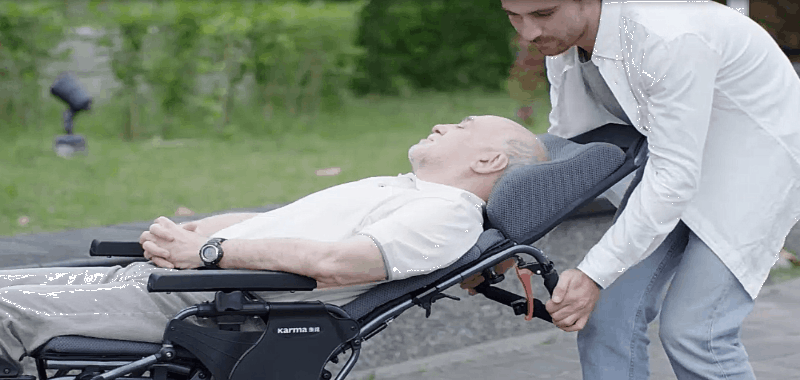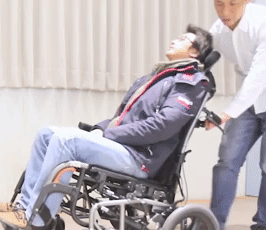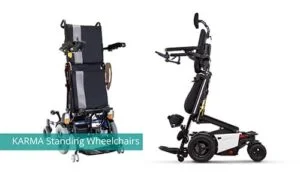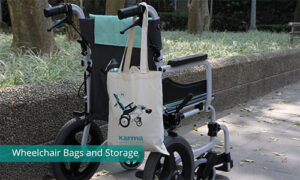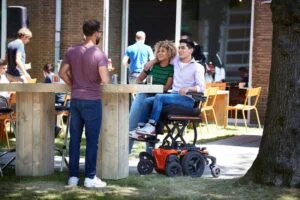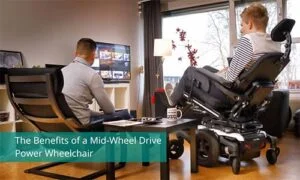When it is time to move the elderly user from the wheelchair to the bed, an awful sound ensues. The sound of Velcro ripping apart that is holding the elderly user in the chair.
We hear all the time families telling us they use the straps because their elderly relative will “fall forward”, is “easily agitated” or even “because it is safer to tie them to the chair!” For elderly users who are conscious and responsive, being bound to a wheelchair must feel hot, uncomfortable, and even inhumane!
The seat restraint isn’t always a bad tool, however there are other solutions that would make the users and caregivers’ lives easier and prevent the elderly user from sliding forward in the wheelchair.
How do you Prevent the User from Sliding Forward?
Why does the elderly user slide forwards? Some long-term wheelchair users have poor torso control, the limited hip angle range of motion, or the wrong size wheelchair i.e. the seat depth is too deep. The user will then try to find a more comfortable and stable position in the wheelchair and slide forward. In this case, we can prevent the likelihood of the user sliding by tackling the “seat” problem.
Solution 1: Ergonomic Seat Design
Most wheelchair seats are flat, but there are seat frames designed to curve along the human body to evenly distribute hip pressure, improve riding comfort, increase stability, and most importantly reduce the possibility of sliding down the wheelchair. This is a great method for those who are using a wheelchair less than few a hours per day and still have upper body control. However, if the user is using the wheelchair for long periods of time or has an unbalanced pelvis, then we recommend using an air seat cushion.
Solution 2: Air Cushion
There are many brands of air cushions on the market that serve different needs. The following comparison table shows the different properties of each seat cushion:
 |
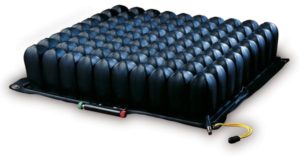 |
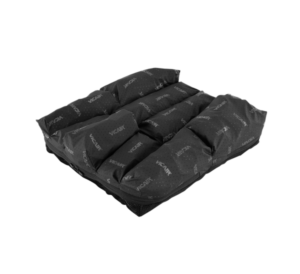 |
|
| Wheelchair Cushion Form | Liquid Gel | Interconnected Air Cells | Airbags |
| Ability to Redistribute Pressure | Medium | High | High |
| Stability | Highest | Medium | High |
| Adjustability | Low | High | High |
| Weight | Heavy | Medium | Light |
| Breathability | Low | Medium | High |
| Maintainability | Does not require much maintenance | Needs regular inflation maintenance | Does not require much maintenance |
| Risk of Deflation | Low | High | Low |
How do you Prevent the User from Leaning Forward?
Have you ever sat on a stool for a long period of time? Without any support for your back, all of the body pressure falls on your buttocks. It takes all of your strength to keep your centre of gravity to sit comfortably. However, if someone has poor physical strength then they are likely to succumb to the call of gravity and fall forwards.
Solution 1: Solid Backrest Support
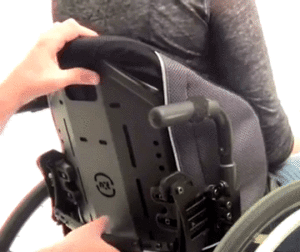
Completely covers the back and can be adjusted from multiple angles.
The solid back support can be adjusted according to the user’s body shape. A combination of curvature and support means the user can sit more stably and more comfortably, with the back angle and depth being adjustable. If you want the elderly user to independently propel the wheelchair, they must first sit firmly and stably so that propelling efficiency can be improved.
Solution 2: Recline and Tilt-in-Space
The use of a backrest can solve part of the user’s body support problem, but if the users can not even sit up straight or the user has very poor torso control, other wheelchair functions have to be in place to prevent them from leaning forward.
The concept is very simple, like a game of tug of war. If the elderly user’s body keeps leaning forward then why don’t we use the opposite force to counter it? For example:
1. Opening the angle of the backrest will allow the user to lie back, so the user won’t lean forward.
2. Tilting the user backward will shift the center of gravity of a user from their hips to their back, making the person more stably positioned in the chair.
If the user’s body is very weak, the elderly user’s family can choose to combine the above two functions, and use the two-in-one wheelchair to recline and “Tilt-in-Space”. Research indicates that when the reclining and “Tilt-in-Space” angle is greater than or equal to 45 degrees and the reclining angle is greater than 10 degrees, there is a significant decompression effect!
Good Mood, Good Health
Whether you are a wheelchair user or a caregiver, both your physical and psychological state of mind matter to us. Choosing the correct wheelchair for the elderly user can reduce psychological stress and physical labor. In turn, these assistive devices should bring about more happiness which is the result that we strive for at the end of the day.

If you need a more personalised selection of assistive devices, you can:
- Find a local assistive center and ask the physical therapist for an evaluation.
- Contact your wheelchair manufacturer or distributor for advice.
- Contact us on Social Media where we can also help answer any questions.
Keep Reading

 Global
Global